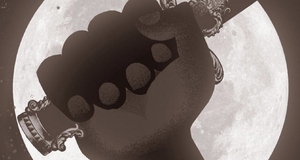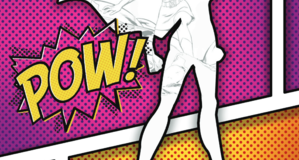Graphic Novels: Preparing for a Mulitmodal and Multiliterate World
By
2014, Vol. 6 No. 08 | pg. 5/5 | « Opposition to Graphic NovelsWhile the benefits of using graphic novels as a supplement to traditional literacy teaching are plentiful, the medium does not come without its criticisms. One of the first barriers for graphic novels to pass through is teachers’ perception of the medium. Connors (2010) explains that “[graphic novels] have a history, and the stigmas that trail in their wake are capable of shaping our perceptions of them as a form of reading material” (para 15). Many teachers initially question the literacy merit of the medium. The rationale for using graphic novels, however, may become clear to those who experience the problems of working with traditional literature and can see the benefits in diversifying their resources. This barrier of perception, however, does not end with the teacher. While Tatavolic (2009) wonders whether the novelty of the comics medium will soon wear out, others (Chute, 2008; Connors, 2010) find that as a literary medium, it has not yet reached cultural acceptance by either academics or students. As Connors points out, “we often seem to proceed under an assumption that students will embrace [graphic novels] unquestioningly, as if they were somehow impervious to the stigmas their elders recognize” (para 15). It is true that a social stigma is attached to the medium but as Versaci (2008) postulates, “if one characteristic of good literature is that it challenges our way of thinking, then comics’ cultural position is such that they are able to mount these challenges in unique ways” (p. 12). With guidance from the teacher, students may learn to ask the right questions and realize the literacy merit that exists within the pages of a graphic novel. ConclusionThe comics medium has endured over a century of literary scrutiny. Though once relegated to minority status, the medium, most recently accessed through the popularized graphic novel, offers its readers a valuable alternative window through which to view the world. Through the existing literature and studies on the use of graphic novels in classrooms, the question: “How can the multimodal and socially diverse material in graphic novels be used to encourage ELL students and reluctant readers to draw from their own experiences, perspectives and multiliteracies to construct meaning and participate in a critical literacy experience?” was investigated. It has been shown that graphic novels have proven effective in reaching students from diverse linguistic and social backgrounds in ways that traditional literature cannot. The scaffolding that the combination of image and text offers, allows students to both contextualize and conceptualize the words while offering flexibility for interpretation and discussion of meaning. This increased access to the meaning making process helps to include all students in critical discussions surrounding topics of relevance and importance. As many of the topics and viewpoints considered in graphic novels are unique to this medium, they allow students to see that diverse perspectives are both recognized and celebrated through the educational discourse. While the medium itself can act as a springboard from which to investigate other forms of text, the perspectives as well, provide a frame through which further readings can be analyzed.Furthermore, as the future of literacy is changing with the dynamics of evolving literacy practices shaping the ways in which we communicate, graphic novels offer a unique reading experience to prepare for multimodal communications. Technology and the Internet are rapidly changing the ways we read and process information. As not all schools are equipped to prepare students for the demands of technology’s influence on literacy, graphic novels can bridge the gap between print and on screen reading. A multiliteracies pedagogy embraces the changing needs of literacy and fosters students’ critical awareness of multimodal texts by using students’ own resources (Chun, 2009). The ability to critically analyze the multiple forms of literature that surround us is essential in a world that is rife with power relations While some reluctance on the part of teachers and students to embrace the comics medium may exist, the need for alternative literacy pedagogy remains. Many of the studies have shown that asking critical questions, which demonstrate the depth of the content of the novels and the skill it takes to read them can mitigate this reluctance. Graphic novels, through their diversity of styles, language, interpretations, and most importantly, creators’ perspectives, can introduce students to literature they might never otherwise encounter (Schwarz, 2002). As Schwarz (2010) states, “perhaps, new media can serve the old purposes of helping adolescents learn about others, appreciate differences, identify injustice and intolerance, and become motivated to act for a better world. A tall order, but worth a try” (Schwarz, 2010, para 1). ReferencesBoatright, M. D. (2010). Graphic journeys: Graphic novels’ representations of immigrant experiences. Journal of Adolescent and Adult Literacy, 53(6), 468-476. Carrier, D. (2000). Aesthetics of Comics. University Park, PA: The Pennsylvania State University Press. Christensen, L.L. (2007). Graphic global conflict: Graphic novels in the highs school social studies classroom. The Social Studies, 97(6), 227-230. Chun, C. W. (2009). Critical literacies and graphic novels for English language learners: Teaching Maus. Journal of Adolescent and Adult Literacy, 53(2), 144-153. Chute, H. (2008). Comics as literature? Reading graphic narrative. Publications of the Modern Language Association of America, 123, 452-465. Chute, H.L. & DeKoven, M. (2006). Introduction: Graphic narrative. MFS Modern Fiction Studies, 52(4), 767-782. Coiro, J. (2003). Reading comprehension on the Internet: Expanding our understanding of reading comprehension to encompass new literacies. The Reading Teacher 56(5), 458-464. Connors, S. P. (2010). "The Best of Both Worlds":
Rethinking the Literary Merit of Graphic Novels. The Alan Review, 37(3). Retrieved from http://scholar.lib.vt.edu/ejournals/ALAN/v37n3/connors.html Cromer, M. & Clark, P. (2012). Getting graphic with the past: Graphic novels and the teaching of history. Theory & Research in Social Education, 35(4), 574-591. Cull, B. W. (2011). Reading revolutions: Online digital text and implications for reading and academe. First Monday, 16(6). Retrieved from http://firstmonday.org/ojs/index.php/fm/article/view/3340/2985 Cummins, J. (2011). The intersection of cognitive and sociocultural factors in the development of reading comprehension among immigrant students. Reading and Writing 25(8), 1973-1990. Daniels, H. & Zemelman, S. (2004). Subjects matter: Every teacher's guide to content-area reading. Portsmouth, NH: Heinemann. Danzak, R.L. (2011). Defining identities through multiliteracies: EL teens narrate their immigration experiences as graphic stories. Journal of Adolescent & Adult Literacy 55(3), 187-196. Eisner, W. (1985). Comics and Sequential Art. Tamarac, Fla.: Poorhouse Press. Goldsmith, F. 2002. Get graphic @ your library: An introduction. American Library Association. Retrieved from http://www.ala.org. Gravett, P. (2005). Graphic novels: Everything you need to know. New York, NY: Collins Design. Frey, N. & Fisher, D. (2004). Using graphic novels, anime, and the Internet in an urban high school. The English Journal 93(3), 19-25. Furrer, C., & Skinner, E. (2003). Sense of relatedness as a factor in children’s academic engagement and performance. Journal of Educational Psychology, 95, 148–162. Grifith, P.E. (2010). Graphic novels in the secondary classroom and school libraries. Journal of Adolescent and Adult Literacy, 54(3), 181-189. Groensteen, T. (2000). Why are comics still in search of cultural legitimization? In Heer, J. & Worcester, K. (Eds.), A comics studies reader (pp. 3-11). Jackson, MS: University Press of Mississippi. Groensteen, T. (2007). The impossible definition. In Heer, J. & Worcester, K. (Eds.), A comics studies reader (pp. 124-131). Jackson, MS: University Press of Mississippi. Guthrie, J. T. (2004). Teaching for literacy engagement. Journal of Literacy Research, 36, 1–30. Guthrie, J.T., Van Meter, P., McCann, A.D., Wigfield, A., Bennett, L., Poundstone, C.C., Rice, M.E., Faibisch, F.M., Hunt, B., & Mitchell, A.M. (1996). Growth of literacy engagement: Changes in motivations and strategies during concept-oriented reading instruction. Reading Research Quarterly, 31(3), 306-332. Guthrie, J.T., Wigfield, A., Barbosa, P., Perencevich, K.C., Taboada, A., Davis, M.H., Scafiddi, N.T., & Tonks, S. (2004). Increasing reading comprehension and engagement through concept-oriented reading instruction. Journal of Educational Psychology, 96(3), 403-423. Hatfield, C. (2005). Alternative comics: An emerging literature. Jackson, MS: University Press of Mississippi. Herrera, M. J. (2013). Toward a definition of information design. Professional Communication Conference (IPCC), 2013 IEEE International, Canada, 1-7. doi: http://dx.doi.org.qe2a-proxy.mun.ca/10.1109/IPCC.2013.6623932 Horn, R. E. (1999). Information design: Emergence of a new profession. In Jacobson, R. E. (Ed), 1999. Information design. (pp. 15-33). Cambridge, MA: MIT Press Lavin, M. R. (1998). Comic books and graphic novels for libraries: What to buy. Serials Review, 24(2), 31-46. Loewen, J.W. (1995). Lies my teacher told me: Everything your American history textbook got wrong. New York: Simon & Schuster. Leu, D.J. (2000). Literacy and technology: Deictic consequences for literacy education in an information age. In M.L. Kamil, P.B. Mosenthal, P.D. Pearson, & R. Barr (Eds.), Handbook of reading research (Vol. 3, pp. 743–770). Mahwah, NJ: Lawrence Erlbaum Associates. Leu, D. J., McVerry, J.G., O’Byrne, W.I., Kiili, C., Zawilinski, L., Everett-Cacopardo, H., Kennedy, C., & Forzani, E. (2011). The new literacies of online reading comprehension: Expanding the literacy and learning curriculum. Journal of Adolescent & Adult Literacy 55(1), 5-14 Lesaux, N., Koda, K., Siegel, L., & Shanahan, T. (2006). Development of literacy. In D. August & T. Shanahan (Eds.), Developing literacy in second-language learners: Report of the National Literacy Panel on Language-Minority Children and Youth. Mahwah, NJ: Lawrence Erlbaum Associates. McCloud, S. (1993). Understanding comics: The invisible art. New York, NY: HarperCollins Publishers, Inc. McCloud, S. (2000). Reinventing comics: How imagination and technology are revolutionizing an art form. New York, NY: HarperCollins Publishers, Inc. New London Group. (1996). A pedagogy of multiliteracies: Designing social futures. Harvard Educational Review, 66(1), 60–92. New York Times Best Sellers. (2014). Graphic books [data file]. Retrieved from http://www.nytimes.com/best-sellers-books/paperback-graphic-books/list.html Organisation for Economic Cooperation and Development. (2004). Messages from PISA 2000. OECD: Paris Organisation for Economic Cooperation and Development. (2013). PISA 2015 Draft Reading Literacy Framework. OECD: Paris Paris, D. (2012). Culturally sustaining pedagogy: A needed change in stance, terminology and practice. Educational Researcher 41(3), 93-97 Schwartz, G (2002). Graphic novels for multiple literacies. Journal of Adolescent and Adult Literacy, 46(3), 282-285. Schwartz, G. (2007). Media literacy, graphic novels and social issues. SIMILE: Studies in Media & Literacy Education, 7(4), 1-11. Schwarz, G. (2010). Graphic novels, new literacies and good old social justice. The Alan Review, 37(3). Retrieved from http://scholar.lib.vt.edu/ejournals/ALAN/v37n3/schwarz.html Tatavolic, M. (2009). Science comics as tools for science education and communication: A brief, explanatory study. Journal of Science Communcation 8(4), 1-17 Retrieved from http://jcom.sissa.it/archive/08/04/Jcom0804(2009)A02/Jcom0804(2009)A02.pdf Versaci, R. (2007). This Book contains graphic language: Comics as literature. New York, NY: The Continuum International Publishing Group Witek, J. (1989). Comic books as history: The narrative art of Jack Jackson, Art Spiegelman and Harvey Pekar. Jackson: MS. University Press of Mississippi. Yahgulanaas, M. N. (2011). Old Growth. L. Park (Ed.). Vancouver, BC: Red Leaf 1.) Comics, plural in form, is used with a singular verb (McCloud, 1993, p. 20). Suggested Reading from Inquiries Journal
Inquiries Journal provides undergraduate and graduate students around the world a platform for the wide dissemination of academic work over a range of core disciplines. Representing the work of students from hundreds of institutions around the globe, Inquiries Journal's large database of academic articles is completely free. Learn more | Blog | Submit Latest in Education |


















